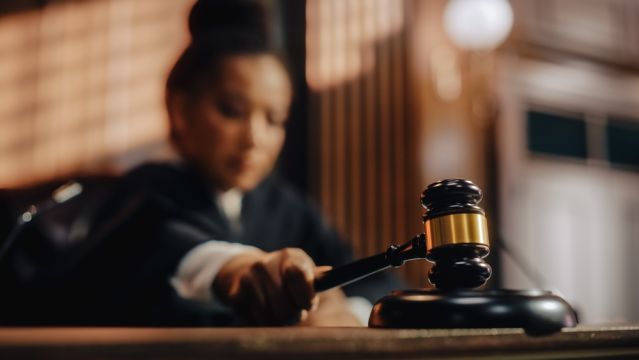I am fortunate to consider this month’s guest author a good friend and close collaborator. I am grateful that she took the time to write this contribution, as I am in the middle of a professional and personal return to Iowa State University.
Kelsey S. Henderson is an Associate Professor of Criminology and Criminal Justice at Portland State University. Her research focuses on the American judicial system, specifically legal decision-making (e.g., defendants’ plea decisions and judicial decision-making).
In the United States, judges do a lot. Want a divorce? You’ll likely need a judge. Suing your neighbor? You’ll likely need a judge. Pleading guilty to a crime? You’ll definitely need a judge. Judicial participation in plea-bargaining often gets overlooked; after all, judges are largely absent from the meat and potatoes of crafting the agreement, they only show up at the end to reject or approve the deal. But they are responsible for evaluating the constitutionality of a guilty plea—that is, is the defendant making a knowing, intelligent, and voluntary decision? Without this judicial determination, the millions of Americans who plead guilty each year would be unable to do so.

The primary methods for judges to determine whether plea decisions are “knowing, intelligent, and voluntary” (i.e., constitutional) are through oral plea colloquies or written tender-of-plea forms in which defendants answer questions or make attestations about their decision-making. Questions such as, “Are you pleading guilty of your own free will because you are guilty?” are commonplace. Judges primarily rely on defendants’ verbal responses (e.g., articulating understanding without looking to one’s attorney) and non-verbal cues (e.g., signs of reluctance) as indicators of knowing, intelligent, and voluntary decisions. But both come with potential issues—for example, expressions such as “err” and “umm” might be indicative of nervousness or confusion, not reluctance.
Ensuring the constitutionality of plea decisions is fundamental to a system of fairness because by pleading guilty, defendants waive many rights (e.g., to present evidence and confront witnesses) and often, their liberty. According to judges, defendants often do not understand the rights that they are waiving. Could extending judges’ involvement beyond the plea colloquy, which typically lasts only minutes, put judges in a better position to evaluate the constitutionality of the plea? Building on their current role as a referee, should we encourage a system where judges get off the sidelines and do more?
In many U.S. states and the federal courts system, judges are prohibited from being involved in plea discussions/negotiations. A recent Courts of Appeals for the 6th Circuit decision reaffirmed this—a district court judge expressed hesitancy to accept a plea agreement that contained certain unfavorable terms for the defendant. Upon appeal, the court ruled that by expressing disapproval prior to the terms being set, the judge inappropriately interfered, and even though “the district court’s [judge’s] conduct may have been motivated in good faith by its concern for defendants, there is ‘no good motives exception’.” In this case, the judge sought to protect the defense and prosecutor’s time by stating the court would not accept a plea with specific terms. However, in doing so, they violated federal procedure.
But what if judges could “act in good faith” and serve as a mediator between two adversarial sides?
In at least eight states, judges are permitted to be involved in plea negotiations. For example, in Oregon, “any other judge [other than the trial judge], at the request of both the prosecution and the defense…may participate in plea discussions.” This involvement is purely advisory, but defense attorneys note that it can be a useful tool if either the defendant or the prosecutor are being unreasonable in their expectations. Judicial involvement provides an objective, third-party perspective, in which the judge can ensure the plea offer is similar to pleas offered to similarly-situated defendants, creating consistency and predictability in a process that otherwise operates behind closed doors.
Judicial involvement in plea negotiations could come with risks (e.g., undermining the perceived neutrality of the judge), but with adequate safeguards, such as protecting disclosed information during discussions, the benefits may outweigh the concerns. Particularly in a fast-paced “meet ‘em and plead ‘em” system, judicial conferences may be defendants’ main opportunity to speak and feel heard, an important component of perceptions of procedural justice.
Judges who are permitted to be involved in plea negotiations believe this type of involvement saves the court time, amongst other positive outcomes such as helping to reach a fairer resolution, protecting defendants’ interests, etc. Saving the courts time and resources is more important now than ever, considering how the COVID-19 pandemic exacerbated existing challenges for the courts. Couple that with the shortage of judges (amongst others in the law enforcement and courts systems) that is slowing down an already clogged system post-COVID. As one article notes, divorce cases that typically would have been resolved in a year, are bleeding into their third or fourth year. Balancing efficiency with efficacy seems to be a key challenge the courts face moving forward. Determining how judges can play a smarter role resolving cases may be the solution. Ultimately, judges could do more to ensure the fairness, expediency, and transparency of the plea-bargaining process. But how and with what resources is unfortunately the reality.
This post was originally published on this site be sure to check out more of their content.






